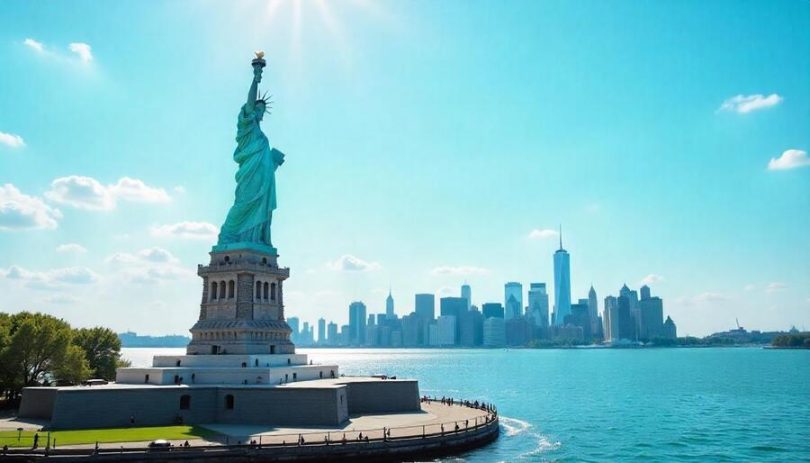Monday, July 7, 2025
The US is projected to forfeit more than twenty-five billion dollars in international tourism revenue this year, driven by stringent immigration restrictions and isolationist trade strategies originating during the Trump administration. Elevated visa barriers, prohibitions on visits, and diplomatic rows have deterred foreign visitors in addition to tarnishing the country’s global reputation as a friendly destination. As tourists increasingly turn towards safer and friendlier alternatives like Europe and Mexico, visitor traffic and spending take significant blows for the United States, culminating in it being the only nation in nearly two hundred that estimates 2025 overseas traveling income reduction.
The United States is set to face an alarming downturn in international travel revenue by 2025, a trend experts are attributing to tightened immigration regulations and escalating trade tensions. Once a leading destination for global tourists, the country is now seeing a shift in visitor patterns—highlighting how domestic policy can significantly influence global mobility and tourism economics.
Tourism Decline Predicted Despite Global Growth
The international travel sector is rebounding strongly post-pandemic, with global spending and movement steadily rising across most regions. In a surprising divergence from global trends, the United States is expected to be the sole country out of 184 worldwide to experience a decline in spending by international tourists in 2025.
Data from the World Travel and Tourism Council indicates that the United States may face a potential decline of 12.5 billion dollars in foreign visitor spending over the coming year. Even more sobering, revised estimates from Tourism Economics, a subsidiary of Oxford Economics, forecast a tourism revenue shortfall reaching up to $28.8 billion—an unexpected blow for the world’s largest economy.
Policy Shifts Create a Hostile Visitor Climate
The sharp drop in international travel interest is being linked directly to border policies that have become increasingly restrictive in recent years. Tightened visa approvals, reduced consular capacity abroad, and a rising perception of unwelcoming attitudes have collectively painted the United States as a less accessible destination.
Analysts point to a systemic tightening of immigration procedures, longer wait times for visitor visas, and lingering negative associations with past travel bans and tariffs. As these factors compound, tourists are finding more hospitable alternatives elsewhere.
This is not merely a matter of perception. The red tape and real logistical hurdles now involved in entering the United States have rendered the country a less attractive choice—especially for those traveling from visa-required nations. Destinations once eager to visit the U.S. are now redirecting travel plans to other regions that are more welcoming and easier to access.
From Recovery to Reversal: Forecasts Rewritten
Earlier in the year, there was cautious optimism among tourism analysts. Tourism Economics had originally projected a 9% increase in international visitor arrivals to the United States for 2025, alongside a potential $16.3 billion gain in tourism revenue. However, the outlook has flipped dramatically as new data and behavioral trends emerged.
Instead of growth, a contraction is now forecasted, sending a ripple of concern through the broader tourism and hospitality sector. The reversal is not isolated to any one market but is rather the result of simultaneous declines from multiple key visitor sources.
Canadian Market Dwindles Amid Visa Woes and Policy Anxiety
Among the hardest-hit segments is the Canadian inbound tourism market. Canada consistently ranks as the number one source of international tourists to the United States, yet projections now suggest a 20% drop in Canadian visitors by 2025.
In 2024, Canadian travelers spent over $20.5 billion in the U.S., representing nearly one-quarter of all international visitor expenditure. Losing even a portion of this market could substantially destabilize border economies and reduce occupancy in hotel and transport sectors across major U.S. destinations.
Analysts suggest that ongoing border-related uncertainty and cumbersome re-entry protocols have led many Canadian travelers to seek vacation alternatives in Europe, Asia, or closer to home. Additionally, the increasing allure of Mexico’s beach resorts and cultural destinations is drawing more attention north of the U.S.-Mexico border.
Mexico Emerges as a Major Beneficiary of Tourism Diversion
While the United States navigates a projected decline, neighboring Mexico is experiencing a significant tourism boom. The WTTC estimates Mexico’s tourism-linked GDP will grow by a record $281 billion in 2025—a sharp contrast to its northern neighbor.
Mexico’s open-border stance, streamlined entry processes, and heavy investment in tourism infrastructure have positioned it as a top alternative for international travelers, especially those from Canada, Europe, and South America. It is now increasingly seen not only as a sun-and-sea getaway but also as a culturally rich destination that offers easier access and better value.
This shift in travel preferences is expected to have long-term implications. With each passing year, loyal tourists who once frequented the U.S. may find new favorites in destinations that proactively welcome them.
Broader Economic Repercussions for the United States
The decline in international tourism does not only affect airlines and hotels—it has a domino effect across a wide array of sectors. Retail, food services, real estate, event planning, entertainment, and ground transportation all depend heavily on tourism inflows.
International travelers are especially valuable as they tend to spend more per trip than domestic visitors. A shortfall in this high-spending segment thus represents a disproportionate economic loss, particularly in urban centers such as New York City, Los Angeles, Miami, and Las Vegas, which rely on international tourism as a major revenue stream.
Hospitality industry associations warn that job growth may stagnate or even reverse if this downward trajectory continues. Destinations that previously invested heavily in tourism infrastructure may also find their return on investment delayed or diminished.
Trade Policy and Tariffs Impacting Perceptions
The situation is further exacerbated by the chilling effect of trade tariffs and geopolitical rhetoric. Increased tariffs on goods and ongoing trade disputes with major economies such as China, the European Union, and Latin America have created tensions that now extend beyond commerce.
Tourism experts note that countries affected by tariffs and diplomatic discord are less likely to promote the U.S. as a travel destination. In turn, travelers from these countries may perceive the U.S. as unwelcoming or adversarial—subconsciously or explicitly steering them toward destinations that are perceived as politically neutral or more open.
This intertwining of politics and travel is becoming an increasingly influential factor in destination decision-making.
Missed Opportunities in a Global Tourism Boom
While much of the world prepares to ride a wave of post-pandemic tourism resurgence, the U.S. risks being left behind. Global travel is projected to surpass pre-pandemic levels in 2025, with international visitor spending rising in Europe, Southeast Asia, the Middle East, and even parts of Africa.
The United States, however, stands as an outlier. Instead of expanding its market share of global tourism, it is expected to lose ground—along with billions in associated revenue.
Given the sheer size of the U.S. economy, even a few percentage points of lost tourism equate to tens of thousands of jobs, missed investment opportunities, and a weakening competitive position in the global travel market.
Path Forward: Rebuilding Confidence and Access
Tourism experts argue that reversing the downward trend will require a multifaceted approach. The first step is restoring traveler confidence—especially from markets that have seen reductions in visa approvals or prolonged processing times.
Second, the U.S. could benefit from modernizing its digital infrastructure for visitor applications, streamlining entry procedures at airports, and restoring tourism promotion programs previously scaled back.
Lastly, rethinking how domestic policies resonate globally is essential. While national security remains important, crafting immigration and trade policies that balance safety with openness could help the U.S. regain its status as a top-tier international destination.
An Urgent Call for Policy Recalibration
The anticipated loss of 28.8 billion dollars in international tourism revenue goes beyond mere numbers—it signals significant economic disruption, lost growth potential, and a shrinking presence for the United States in the competitive global travel market. As destinations worldwide expand their hospitality and accessibility, the U.S. must decide whether to remain insular or reclaim its place as a welcoming and dynamic destination for global travelers.
America this year will lose over twenty-five billion USD in foreign tourism due to deterrent immigration and trade policy actions taken in the Trump era. They have made the country further inaccessible and unfriendly as a destination to foreign tourists, which has encouraged them to turn elsewhere.
If the current trajectory continues, the United States risks turning its once-thriving tourism sector into a cautionary tale of how domestic policies can ripple outward—with costly global consequences.











